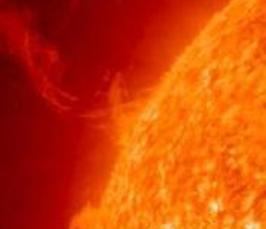ESP Online Seminar: 2D and 3D Kinematic Analysis of an Ideal-MHD Prominence Eruption (Thomas Rees-Crockford)
ESPOS
- Date: Apr 25, 2019
- Time: 11:00 AM - 12:00 PM (Local Time Germany)
- Speaker: Thomas Rees-Crockford
- Northumbria University, Newcastle upon Tyne, England
- Location: Northumbria University (broadcasted at MPS)
- Room: Auditorium
- Host: Andreas Lagg

We carry out multi-dimensional kinematic analysis of a prominence eruption in order to characterise the role of eruptive ideal-MHD instabilities. Using SDO/AIA and STEREO/EUVI-A we reconstruct the leading edge of the prominence in 3D, as observed between 26-Feb-2013 20:30:00 UT and 27-Feb-2013 05:45:00 UT. We use a novel semi-automated, dual, edge detection method to precisely detect the leading edge and create height-time profiles from SDO/AIA image sequences in He II 30.4 nm, to analyse the kinematics of erupting plasma along radial slits intersecting the leading edge coordinates. Constraining the power index parameter of fitted functions characterizing the linear and non-linear phases of the eruption, we investigate a set of fits of the eruption profile across all slits and identify the best fit in order to compare different eruption mechanisms. We also parameterise the onset time of the acceleration phase in order to confine the start time of the torus instability. For the first time, 3D kinematic analysis has identified a significant delay in the onset time of the acceleration phase together with a corresponding critical height at which acceleration starts to occur, as a function of position along the leading edge, which is in remarkable agreement with the determination of the critical height according to the decay index governing the torus instability.